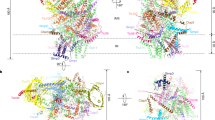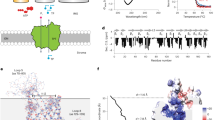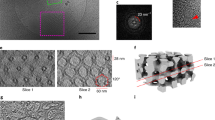Abstract
DURING photosynthetic CO2 fixation, fixed carbon is exported from the chloroplasts in the form of triose phosphate by the chloroplast phosphate translocator, which is the principal polypeptide (E29) from spinach chloroplast envelopes1. We have sequenced this nuclear-coded envelope membrane protein from both spinach and pea chloroplasts2,3. An envelope membrane protein, E30, has been identified as a possible receptor for protein import into pea chloroplasts using an anti-idiotypic antibody approach4–6; antibodies raised against purified E30 inhibited binding and import of proteins into chloroplasts7. The amino-acid sequence of E30 deduced from its complementary DNA7 turned out to be highly homologous to that of E29, assigned by us as the spinach phosphate translocator2, and was identical to the corresponding polypeptide from pea chloroplasts3. Differences in the binding properties to hydroxylapatite of £30 and the phosphate translocator suggested that E30 was not responsible for the chloroplast phosphate-transport activity but was the chloroplast import receptor7. Here we present evidence that argues against this and which identifies E30 as the chloroplast phosphate translocator.
This is a preview of subscription content, access via your institution
Access options
Subscribe to this journal
Receive 51 print issues and online access
$199.00 per year
only $3.90 per issue
Buy this article
- Purchase on Springer Link
- Instant access to full article PDF
Prices may be subject to local taxes which are calculated during checkout
Similar content being viewed by others
References
Flügge, U.-I. & Heldt, H. W. in Function and Molecular Aspects of Biomembrane Transport (eds Quagliariello E., Palmieri F. & Klingenberg E. M.) 373–382 (Elsevier/North Holland, Amsterdam 1979).
Flügge, U.-I. et al. EMBO J. 8, 39–46 (1989).
Willey, D. L., Fischer, K. Wachter, E., Link, T. A. & Flügge, U. I. Planta 183, 451–461 (1991).
Pain, D., Kanwar, Y. S. & Blobel, G. Nature 331, 232–237 (1988).
Joyard, J. & Douce, R. Nature 333, 306–307 (1988).
Pain, D. & Blobel, G. Nature 333, 307 (1988).
Schnell, D. J., Blobel, G. & Pain, D. J. Cell Biol. 111, 1825–1838 (1990).
Rumpho, M. E., Edwards, G. E., Yousif, A. E. & Keegstra, K. Plant Physiol. 86, 1193–1198 (1988).
Gross, A., Brücker, G., Heldt, H. W. & Flügge, U. I. Planta 180, 262–271 (1990).
Flügge, U. I. & Heldt, H. W. Biochim. biophys. Acta 638, 296–304 (1981).
Klingenberg, M. in Membranes and Transport (ed Martinosi, A. N.) Vol. 1, 203–209 (1982).
Lin, C. & Klingenberg, M. Biochemistry 21, 2950–2956 (1982).
Flügge, U.-I. & Heldt, H. W. FEBS Lett. 82, 29–33 (1977).
Cline, K., Werner-Washburne, M., Andrews, J. & Keegstra, K. Plant Physiol. 75, 675–678 (1984).
Cline, K., Werner-Washburne, M., Lubben, T. H. & Keegstra, K. J. biol. Chem. 260, 3691–3696 (1985).
Hinz, G. & Flügge, U. I. Eur. J. Biochem. 175, 649–659 (1988).
Block, M. A., Dorne, A. J., Joyard, J. & Douce, R. J. biol. Chem. 258, 13273–13280 (1983).
Salomon, M., Fischer, K., Flügge, U. I. & Soll, J. Proc. natn. Acad. Sci. U.S.A. 87, 5778–5782 (1990).
Waegemann, K. & Soll, J. The Plant J. (in the press).
Kiebler, M. et al. Nature 348, 610–616 (1990).
Zara, V. et al. Eur. J. Biochem. 198, 405–410 (1991).
Phelps, A., Schobert, C. & Wohlrab, H. Biochemistry 30, 248–252 (1991).
Pain, D., Murakami, H. & Blobel, G. Nature 347, 444–449 (1990).
Murakami, H., Blobel, G. & Pain, D. Nature 347, 488–491 (1990).
Friedman, A. L. & Keegstra, K. Plant Physiol. 89, 993–999 (1989).
Laemmli, U. K. Nature 227, 680–685 (1970).
Bonner, W. M. & Laskey, R. A. Eur. J. Biochem. 46, 84–88 (1974).
Lowry, O. H., Rosebrough, N. J., Farr, A. L., & Randall, R. J. J. biol. Chem. 193, 265–275 (1951).
Heldt, H. W. Meth. Enzym. 69, 604–613 (1980).
Keegstra, K. & Youssif, A. E. Meth. Enzym. 118, 316–325 (1986).
Author information
Authors and Affiliations
Rights and permissions
About this article
Cite this article
Flügge, UI., Weber, A., Fischer, K. et al. The major chloroplast envelope polypeptide is the phosphate translocator and not the protein import receptor. Nature 353, 364–367 (1991). https://doi.org/10.1038/353364a0
Received:
Accepted:
Issue Date:
DOI: https://doi.org/10.1038/353364a0
Comments
By submitting a comment you agree to abide by our Terms and Community Guidelines. If you find something abusive or that does not comply with our terms or guidelines please flag it as inappropriate.



